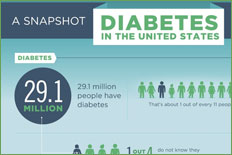Health Centers > Diabetes Center > Chronic Complications of Diabetes
Chronic Complications of Diabetes
Late clinical manifestations of diabetes mellitus include a number of pathologic changes that involve small and large blood vessels, cranial and peripheral nerves, the skin, and the lens of the eye. These lesions lead to hypertension, renal failure, blindness, autonomic and peripheral neuropathy, amputations of the lower extremities, myocardial infarction, and cerebrovascular accidents. These late manifestations correlate with the duration of the diabetic state subsequent to the onset of puberty. In type 1 diabetes, end-stage renal disease develops in up to 40% of patients, compared with less than 20% of patients with type 2 diabetes.
Diabetes Complications and Prevention
The Glucose Connection
Other Things You Can Do
Dealing with Complications
Cardiovascular Disease
Retinopathy
Nephropathy
Neuropathy
Types of Neuropathy and Treatment
Infections
As regards proliferative retinopathy, it ultimately develops in both types of diabetes but has a slightly higher prevalence in type 1 patients (25% after 15 years' duration). In patients with type 1 diabetes, complications from end-stage renal disease are a major cause of death, whereas patients with type 2 diabetes are more likely to have macrovascular diseases leading to myocardial infarction and stroke as the main causes of death. Cigarette use adds significantly to the risk of both microvascular and macrovascular complications in diabetic patients.
While diabetes care has improved greatly in recent decades, there are still millions of people dying from the disease annually. According to the IDF there were 4.8 million diabetes-related deaths in 2012.
Many with the condition lose their eyesight or require amputations because of poorly controlled diabetes. Lack of access to medicine or doctors who can tell them how to use it is in some cases to blame. For others, it is because the treatment they receive is inadequate. Fear of the consequences of low blood sugar (hypoglycaemia), a common side effect of insulin treatment, may even result in some people with diabetes maintaining high blood sugar levels, consequently damaging blood vessels and leading to cardiovascular and cerebrovascular disease.
Findings from a landmark study in the UK showed that reducing blood sugar levels by close to 1% may reduce diabetes-related deaths by more than 20% and reduce microvascular complications by nearly 40%.
Chronic complications are responsible for most illness and death associated with diabetes. Chronic complications usually appear after several years of elevated blood sugars (hyperglycemia). Since patients with type 2 diabetes may have elevated blood sugars for several years prior to diagnosis, these patients may have evidence of complications at the time of diagnosis. Basic principles of prevention of complications of diabetes
- Take your medications (pills and/or insulin) as prescribed by your doctor.
- Monitor your blood sugars closely.
- Follow a sensible diet. Do not skip meals.
- Exercise regularly.
- See your doctor regularly to monitor for complications.
The Hypoglycemic States
Spontaneous hypoglycemia in adults is of two principal types: fasting and postprandial. Symptoms begin ...
Over time, the surge and crash of dissolved glucose and insulin that occurs in diabetes can end up causing irreparable damage to many body organs and systems. Doctors refer to this as "end-organ damage" because it can effect nearly every organ system in the body:
Chronic Complications of Diabetes
OCULAR COMPLICATIONS
DIABETIC NEPHROPATHY
DIABETIC NEUROPATHY
- Peripheral neuropathy
- Distal symmetric polyneuropathy
- Isolated peripheral neuropathy
- Painful diabetic neuropathy
- Autonomic neuropathy
- Management of autonomic neuropathy
- Management of erectile dysfunction
CARDIOVASCULAR COMPLICATIONS
SKIN AND MUCOUS MEMBRANE COMPLICATIONS
SPECIAL SITUATIONS
Prognosis
Hypertension (High Blood Pressure) and Heart Disease. Hypertension is almost uniformly found in people with Type 2 Diabetes. As the blood glucose level increases our bodies attempt to use various means to lower the concentration of glucose back to "normal" levels. One way the body attempts to do this is by holding more fluid in the blood vessels. This extra fluid causes the pressure in the vessels to increase. Heightened blood pressure, in turn leads to a generalized weakening of the circulatory system. This can eventually lead to blood vessels bursting in some extreme cases (e.g., vascular stroke) or lead to the development of chronic blood flow problems in the limbs and other peripheral parts of the body. Chronically high insulin levels are also associated with early development of atherosclerotic plaques inside blood vessel walls, which lead to further risk of aneurysm, hypertension, stroke, and heart attack.
Large-vessel disease generally presents as atherosclerotic vascular disease (atherosclerosis). Atherosclerosis in diabetic patients does not differ from that which occurs in nondiabetic patients, although it may occur sooner and progress more rapidly in diabetic than nondiabetic patients. It involves the coronary arteries, the cerebral arteries, and the large arteries (iliac and femoral arteries) that supply blood to the legs. Thus, nonfatal and fatal myocardial infarction (heart attack), stroke, and ulceration and gangrene of the feet, often necessitating amputation, are common in patients with diabetes.
Small-artery disease (microangiopathy) consists of thickening of the walls of small arteries and capillaries, which initially renders them permeable (leaky) to fluids and subsequently renders them prone to obstruction (thrombosis or embolism). These changes occur primarily in the retina (diabetic retinopathy) and kidneys (diabetic nephropathy), and as a result diabetes is the most common cause of blindness and end-stage kidney disease. Vascular complications are aggravated by hypertension and hyperlipidemia (high serum levels of lipids), both of which are common in patients with diabetes.
Eye Disease. Untreated diabetes can lead to a variety of eye problems including blindness and reduced vision. Diabetes is the #1 cause of acquired blindness in people under the age of 65 and is one of the leading causes in older adults. People with diabetes experience damage to blood vessels and nerves in the back of the eye, an area called the retina. This leads to a condition called "Diabetic Retinopathy." Diabetes can also cause abnormal new growth of capillaries inside the retina that degrade blood flow and weaken vision. Once it occurs, damage to vision is permanent. However, when identified early enough, many vision problems associated with diabetes can be repaired or avoided. Individuals with diabetes should have their eyes examined once a year by an eye doctor. People with diabetes can prevent eye problems by keeping their blood glucose under good control, lowering their blood pressure, and cholesterol levels.
Kidney Disease (Nephropathy). The kidneys main job is to filter blood. In those with diabetes, sugar that is filtered from the blood damages the blood vessels in the kidneys over time. This process is called "Diabetic nephropathy." In extreme cases diabetes can lead to kidney failure, necessitating frequent and expensive dialysis (machine filtration of the blood), or risky, expensive, and difficult to obtain kidney transplantation. Diabetes is the number one reason that Americans are on dialysis. Doctors test urine of patients with diabetes to monitor for kidney failure.
Nerve Damage (Neuropathy). Sugar in the blood damages the peripheral nervous system (that part of the nervous system that works the arms, legs and other extremities). Affected patients report pain, tingling or buzzing sensations in their hands and/or feet. Complete numbness (loss of sensation) in the limbs is also common. Patients may also lose bladder control, or the ability to walk. Male loss of ability to function sexually (impotence or erectile dysfunction) may also occur.
Joint and Foot Problems. Poor blood flow in the limbs combined with nerve damage and reduced or deadened sensation lead to a situation where the extremities (feet, hands) become easily susceptible to damage and disease. Damage to joints (caused by lack of ability to feel pain properly) and ulcers of the feet are common. Foot and limb problems related to diabetes can usually be helped with proper treatment. However, left untreated, damage can become infected and require amputation. In 2004 alone, 71,000 Americans required amputation of a foot or leg because of diabetes (CDC, 2008). It is imperative that those individuals with diabetes perform self-foot exams on a daily basis and that they undergo a foot exam by a health professional once a year.
Infections of the Skin. Diabetes can cause a number of skin conditions, including fungal (yeast) and bacterial infections, skin spotting (diabetic dermopathy), and a variety of spots, rashes and bumpy or oddly textured skin patches. Most of these conditions are related to chronically raised blood sugar levels, and become less of a problem once blood sugar is brought under control. Individuals with diabetes are also at increased risk of all types of infection because of impaired immunity (ability to fight infection). For this reason, it is important for people with diabetes to get annual influenza vaccinations and pneumococcal vaccine every five years.
Cognitive Issues. As one of the organs most affected by blood sugar fluctuations, the brain is also impacted by diabetes. Chronic uncontrolled diabetes appears to be associated with memory problems and dementia in the elderly, and may increase risk of Alzheimer's disease. In younger patients with Type 1 diabetes, elevated blood sugar levels were found to be associated with increased difficulty performing mental arithmetic and with decreased verbal fluency performance. This slowing of cognitive functions was reversible as sugar levels decreased.


